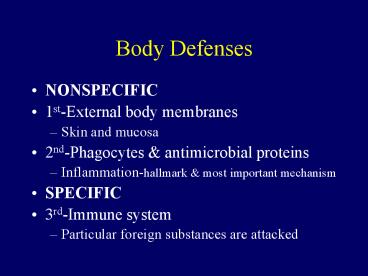Body Defenses - PowerPoint PPT Presentation
1 / 25
Title:
Body Defenses
Description:
Inflammation-hallmark & most important mechanism. SPECIFIC. 3rd-Immune system ... Histamine, Bradykinin, Prostaglandins, Lymphokines all enhance inflammation. ... – PowerPoint PPT presentation
Number of Views:91
Avg rating:3.0/5.0
Title: Body Defenses
1
Body Defenses
- NONSPECIFIC
- 1st-External body membranes
- Skin and mucosa
- 2nd-Phagocytes antimicrobial proteins
- Inflammation-hallmark most important mechanism
- SPECIFIC
- 3rd-Immune system
- Particular foreign substances are attacked
2
Nonspecific Defenses
- Species Resistance
- Uniqueness
- Mechanical Barriers
- Skin
- Mucous membranes
- Chemical Barriers
- Enzymes, etc. in body fluids
- pH of skin 3-5
- Gastric juice
- Lysozyme in tears
- Interferons
3
Nonspecific Defenses
- Inflammation
- Prevents spread to nearby tissues
- Disposes of cell debris and Pathogens
- Sets stage for repair processes
- Histamine, Bradykinin, Prostaglandins,
Lymphokines all enhance inflammation.
4
Nonspecific Defenses
- Phagocytosis
- Neutrophils-die in the battle
- Produce defensins
- Macrophages-survive several battles
- Respiratory burst
- Natural Killer Cells (NKs)
- Secrete chemicals against cell wall
- Enhance inflammatory response
5
(No Transcript)
6
(No Transcript)
7
(No Transcript)
8
Nonspecific Defenses
- Fever
- Regulated by the hypothalamus
- Difficult for bacteria to repair cell walls
- Stimulates WBC activity
9
(No Transcript)
10
(No Transcript)
11
Lymphocyte Functions
- Cell-mediated immunity (CMI)
- Cell to cell contact
- Respond to processed protein fragments
- T cells release cytokines
- Antibody-mediated immunity (AMI)
- B cells differentiate into plasma cells
- Secrete antibodies (immunoglobulins)
12
(No Transcript)
13
(No Transcript)
14
(No Transcript)
15
(No Transcript)
16
Antibody Structure
17
Antibody Types
- IgGmost abundant antibody in plasma
- IgAexocrine gland secretions
- IgMreleased during primary response
- IgDimportant in B cell activation
- IgEassociated with allergic reactions
18
Monoclonal Antibodies
- Produced by descendants of a single cell
- Fusion of tumor cells and B lymphocytes
- Hydridomas
- Uses
- Diagnose pregnancy
- Diagnose some sexually transmitted diseases
- Diagnose types of cancer
19
T-Cell Activation
20
Immunodeficiencies
21
Acquired Immunodeficiencies
- Hodgkins Disease
- Cancer of the lymph nodes
- Symptoms fatigue, fever, night sweats
- AIDS
- Human Immunodeficiency Virus (HIV)
22
Common AIDS-Related Conditions
- (1) Persistant lymphadenopathy
- (2) Fever
- (3) Nausea and vomiting
- (4) Fatigue
- (5) Night sweats
- (6) Headaches
- (7) Persistent diarrhea
- (8) Dementia
- (9) Cancers
- (10) Opportunistic infections
23
Autoimmune Diseases
- Multiple sclerosis
- Myasthenia gravis
- Graves disease
- Type I (juvenile) diabetes mellitus
- Systemic lupus erythematosus
- Glomerulonephritis
- Rheumatoid arthritis
24
Transplantation and Tissue Rejection
- Isograftidentical twin
- Autograftfrom your own body
- Allograftsame species
- Zenograftfrom different species
- Ex. Pig kidneys (54) heart valves (74)
- Immunosupressive drugs are necessary
25
Immune System
- Stress--depresses the immune system
- Macrophages become sluggish
- High levels of endorphins
- High levels of cortisol epinephrine
- Growth hormone depressed
- Short term memory fade
- Cancer autoimmune diseases































